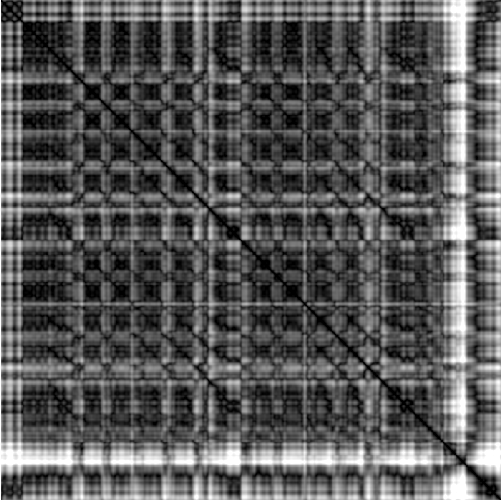24. Der Leiermann. (The Barrel Organ Player)

Variiertes Strophenlied in a-Moll mit fünf Strophen. [more]
Magnitude spectogram (3 sec) weighted by amount of rapid phase changes. [more]
Singer: Randall Scarlata (Baritone), Piano: Jeremy Denk. Recording of a performance at the Isabella Stewart Gardner Museum, Boston.
Source, License: CC BY-NC-ND 2.0
Information about our segmentation of »24. Der Leiermann«
Variiertes Strophenlied in a-Moll mit fünf Strophen.
Die Segmentierung wurde wiederholungsbasiert durchgeführt und entspricht nicht der Stropheneinteilung.
Die erste und die dritte Strophe des Gedichts sind gleich vertont.
Das entsprechende musikalische Segment Aa kann in vier viertaktige Abschnitte unterteilt werden, wobei der erste und der zweite sowie der dritte und der vierte Abschnitte jeweils identisch sind.
Alle vier Abschnitte sind durch ein zweitaktiges instrumentales Zwischenspiel getrennt.
Ab ist sechstaktig und stellt den Abschluss der zweiten bzw. der vierten Strophe des Gedichts dar, wobei die ersten beiden Takte gesungen und die letzte vier rein instrumental sind.
Das letzte Segment J kommt nur ein einziges Mal vor. Die zweite Hälfte ist rein instrumental.
Lyrics: Project Gutenberg
MFCC (Mel Frequency Cepstral Coefficients)
This feature was originally developed for speech analysis and speaker recognition. After transforming a musical signal in a spectrogram representation, MFCC-based features are computed by combining suitable frequency bands into percepually inspired Mel bands and applying a decorrelating discrete cosine transformation. Especially, the lower MFCC bands describe the coarse form of the spectral envelope which correlates to timbre. For deriving MFCC-ENS features (MFCC Energy Normalized Statistics), these MFCC features are quantized, smoothed (in temporal direction), and normalized with respect to the ℓ2-norm.
Furthermore, we present a novel variant of MFCC-ENS features by prior weighting the spectrogram by the second derivative of the spectral phase information in the time domain. This indicates slight changes in pitch which typically occur in vocals and which are not present in piano music. Especially the harmonics of piano-played notes are attenuated by this method which leads to smaller spectral envelopes in the piano sections and hence to more discriminative timbre-related MFCC features.
Literature
- Steven Davis, Paul Mermelstein: Comparison of parametric representations for monosyllabic word recognition in continuously spoken sentences, Readings in Speech Recognition 1990, pp. 65–74.
- Hiroko Terasawa, Malcolm Slaney, Jonathan Berger: The thirteen colors of timbre, WASPAA 2005, pp. 323–326.
- Dirk v. Zeddelmann, Frank Kurth: A construction of compact MFCC-type features using short-time statistics for applications in audio segmentation, EUSIPCO 2009, pp. 1504–1508.
